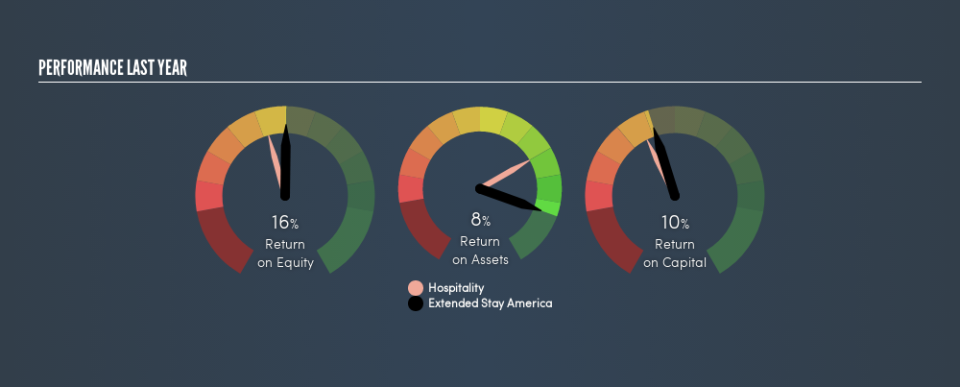What Can We Learn From Extended Stay America, Inc.’s (NASDAQ:STAY) Investment Returns?

Today we'll evaluate Extended Stay America, Inc. (NASDAQ:STAY) to determine whether it could have potential as an investment idea. In particular, we'll consider its Return On Capital Employed (ROCE), as that can give us insight into how profitably the company is able to employ capital in its business.
Firstly, we'll go over how we calculate ROCE. Second, we'll look at its ROCE compared to similar companies. Finally, we'll look at how its current liabilities affect its ROCE.
Understanding Return On Capital Employed (ROCE)
ROCE measures the amount of pre-tax profits a company can generate from the capital employed in its business. All else being equal, a better business will have a higher ROCE. Ultimately, it is a useful but imperfect metric. Author Edwin Whiting says to be careful when comparing the ROCE of different businesses, since 'No two businesses are exactly alike.'
So, How Do We Calculate ROCE?
The formula for calculating the return on capital employed is:
Return on Capital Employed = Earnings Before Interest and Tax (EBIT) ÷ (Total Assets - Current Liabilities)
Or for Extended Stay America:
0.099 = US$369m ÷ (US$3.9b - US$207m) (Based on the trailing twelve months to March 2019.)
Therefore, Extended Stay America has an ROCE of 9.9%.
Want to participate in a short research study? Help shape the future of investing tools and you could win a $250 gift card!
Check out our latest analysis for Extended Stay America
Is Extended Stay America's ROCE Good?
When making comparisons between similar businesses, investors may find ROCE useful. It appears that Extended Stay America's ROCE is fairly close to the Hospitality industry average of 9.5%. Separate from how Extended Stay America stacks up against its industry, its ROCE in absolute terms is mediocre; relative to the returns on government bonds. Investors may wish to consider higher-performing investments.
It is important to remember that ROCE shows past performance, and is not necessarily predictive. ROCE can be misleading for companies in cyclical industries, with returns looking impressive during the boom times, but very weak during the busts. ROCE is only a point-in-time measure. Since the future is so important for investors, you should check out our free report on analyst forecasts for Extended Stay America.
Do Extended Stay America's Current Liabilities Skew Its ROCE?
Current liabilities include invoices, such as supplier payments, short-term debt, or a tax bill, that need to be paid within 12 months. Due to the way the ROCE equation works, having large bills due in the near term can make it look as though a company has less capital employed, and thus a higher ROCE than usual. To counteract this, we check if a company has high current liabilities, relative to its total assets.
Extended Stay America has total assets of US$3.9b and current liabilities of US$207m. Therefore its current liabilities are equivalent to approximately 5.3% of its total assets. With low levels of current liabilities, at least Extended Stay America's mediocre ROCE is not unduly boosted.
Our Take On Extended Stay America's ROCE
Based on this information, Extended Stay America appears to be a mediocre business. You might be able to find a better investment than Extended Stay America. If you want a selection of possible winners, check out this free list of interesting companies that trade on a P/E below 20 (but have proven they can grow earnings).
I will like Extended Stay America better if I see some big insider buys. While we wait, check out this free list of growing companies with considerable, recent, insider buying.
We aim to bring you long-term focused research analysis driven by fundamental data. Note that our analysis may not factor in the latest price-sensitive company announcements or qualitative material.
If you spot an error that warrants correction, please contact the editor at editorial-team@simplywallst.com. This article by Simply Wall St is general in nature. It does not constitute a recommendation to buy or sell any stock, and does not take account of your objectives, or your financial situation. Simply Wall St has no position in the stocks mentioned. Thank you for reading.


